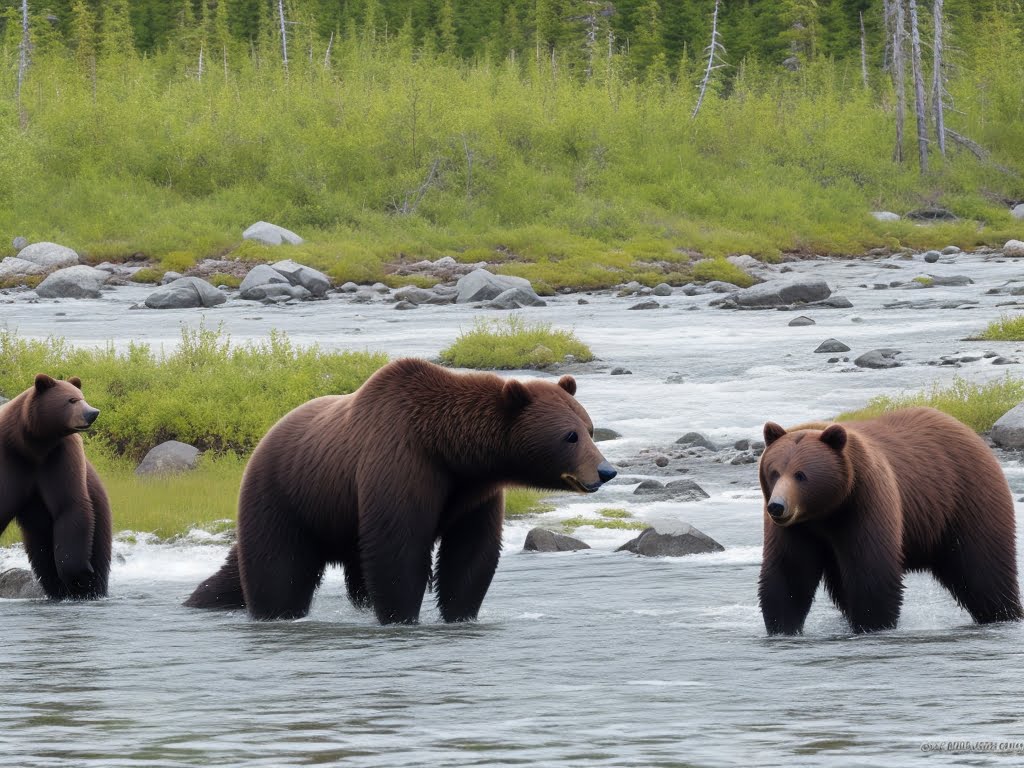When embarking on a shore excursion in Alaska, encountering the state’s magnificent bears is an exhilarating experience that should be approached with caution. To ensure your safety while observing these iconic creatures, it is important to be well-prepared and informed. This article provides valuable safety tips for observing Alaskan bears that will help you coexist harmoniously with Alaska’s bears, allowing for a memorable and awe-inspiring encounter while keeping you out of harm’s way.
Table of Contents
ToggleSafety Tips for Observing Alaskan Bears
Understanding Alaska’s Bears
Alaska is home to several species of bears, each with its own unique characteristics and behavior. The most common bear species found in Alaska include the brown bear, black bear, and polar bear. Understanding these different bear species is essential for safely navigating bear country and knowing how to respond in various situations.
Different Bear Species in Alaska
The brown bear, also known as the grizzly bear, is the largest and most powerful land predator in Alaska. It can weigh up to 1,500 pounds and has a distinctive hump on its shoulders. The black bear, despite its name, can range in color from black to blonde or cinnamon. It is smaller than the brown bear but should never be underestimated. The polar bear, on the other hand, primarily lives in the Arctic region of Alaska and is adapted to survive in freezing temperatures.
Behavior and Characteristics of Alaska’s Bears
Understanding the behavior and characteristics of Alaska’s bears is crucial for ensuring your safety. Brown bears are typically more aggressive than black bears and may exhibit territorial behavior. They are also excellent swimmers and climbers. Black bears, on the other hand, are more shy and reclusive. They are excellent climbers and typically avoid confrontation whenever possible. Polar bears are highly capable swimmers and are skilled hunters both on land and in the water. They can be extremely dangerous if encountered in the wild.
Why Bear Safety is Important
Bear safety is of utmost importance when venturing into Alaska’s bear habitats. Bears, although majestic and fascinating creatures, are powerful and unpredictable. Human-bear encounters can result in harm to both humans and bears. By following proper safety measures, we can minimize the chances of negative interactions and ensure the well-being of both humans and bears.
Preparing for Bear Encounters
Proper preparation is key to handling bear encounters safely and responsibly. Taking the time to research the area, choosing a knowledgeable guide, understanding bear behavior, knowing bear signs, and preparing the necessary gear and equipment will greatly increase your chances of a safe and enjoyable experience.
Researching the Area
Before setting foot in bear territory, it is essential to research the specific region you plan to visit. Familiarize yourself with the local bear species’ behavior patterns, recent bear activity reports, and any bear safety guidelines that exist for the area. This information will better equip you to navigate the environment and make informed decisions.
Choosing a Knowledgeable Guide
Having a knowledgeable guide by your side can significantly enhance your safety during bear encounters. Guides are often trained in bear behavior and can provide valuable insight and guidance. They know the best areas to observe bears from a safe distance and can also educate you on the wildlife and ecosystem of the area.
Understanding Bear Behavior
Understanding bear behavior is paramount in ensuring your safety. Bears are inherently wild animals and should never be approached or provoked. Observing them from a safe distance and avoiding actions that may trigger defensive or aggressive behavior is crucial. Knowledge of their body language and vocalizations can provide essential cues on how to react in different situations.
Knowing Bear Signs
Learning to recognize bear signs can help you avoid potential encounters. Bear signs include footprint tracks, scat, claw marks on trees, and overturned rocks or logs that indicate recent bear activity. Being aware of such signs can help you adjust your route or take appropriate precautions.
Gear and Equipment Preparation
Before heading into bear country, ensure you have the necessary gear and equipment to handle potential encounters. Bear spray, a non-lethal deterrent specifically designed to ward off bears, should be carried and readily accessible. Bear-resistant containers are essential to store food and other odorous items, keeping them secure and reducing the risk of attracting bears to your campsite.
Maintaining a Safe Distance
Maintaining a safe distance from bears is crucial for both your safety and the well-being of the bears. Understanding what constitutes a safe distance, estimating distance accurately, and using tools such as binoculars or a telephoto lens will help you observe these magnificent creatures without endangering yourself or disturbing them.
Overview of Safe Distance
A safe distance refers to the distance at which you can observe bears without interfering with their natural behavior or triggering any defensive actions. The recommended safe distance is a minimum of 300 feet (or about 100 meters) for brown bears and at least 150 feet (or about 50 meters) for black bears. For polar bears, it is paramount to maintain a distance of at least 300 yards (or about 275 meters) due to their aggressive nature.
Methods to Estimate Distance
Estimating distance accurately can be challenging, especially in vast landscapes. However, several methods can help you gauge how far away you are from a bear. Comparing the bear’s size to familiar objects or landmarks, such as trees or rocks, can provide a rough estimate. Additionally, using a range finder or smartphone apps specifically designed for measuring distance can be helpful tools to ensure a safe distance is maintained.
Using Binoculars or a Telephoto Lens
Binoculars or a telephoto lens are invaluable tools for observing wildlife, including bears, from a safe distance. They allow for detailed observation without the need to approach too closely. Remember to purchase binoculars or lenses with appropriate magnification that will enable you to view the bears clearly without sacrificing your safety.
Understanding Bear Reactions to Closeness
Bears may react differently to humans depending on their distance and the circumstances. Approaching too closely can make bears feel threatened, triggering defensive behavior. Being aware of signs of stress or agitation, such as vocalizations, swaying, or charging, is crucial. If you notice any of these signs, it is best to slowly retreat while avoiding any sudden movements.
Communicating with Bears
Proper communication with bears is essential to ensure they are aware of your presence and maintain their distance. By making noise to alert bears, identifying yourself as human, avoiding sudden movements, and approaching bears with caution when necessary, you can reduce the likelihood of surprising or startling them.
Making Noise to Alert Bears
Bears have excellent hearing, and making noise while hiking can alert them to your presence. It is a good practice to talk, sing, or clap your hands at regular intervals to let bears know you are approaching. This will give them a chance to recognize you as human rather than a potential threat.
Identifying Yourself as Human
When in bear country, it is important to identify yourself as a human and not as prey. Bears usually avoid humans, so it is recommended to speak calmly and loudly, giving them the opportunity to recognize you as a fellow species and not a threat. Avoid making sudden or erratic movements that could be misinterpreted as hostile behavior.
Avoiding Sudden Movements
Sudden movements can startle bears and trigger defensive or aggressive behavior. It is essential to move slowly and deliberately, giving bears ample time to assess your presence. If you need to retrieve something from your backpack or take a photograph, do so slowly and avoid any quick gestures that may be perceived as a threat.
Approaching Bears with Caution
While the general rule is to maintain a safe distance from bears, there may be instances where it is necessary to approach bears cautiously, such as for research purposes. In such cases, it is crucial to prioritize safety and work with trained professionals who understand bear behavior and can guide you through the process safely.
Avoiding Food-Related Problems
Food-related problems are one of the main causes of bear-human conflicts. Properly storing and securing food, disposing of waste correctly, considering cooking and eating practices, using bear-resistant containers, and maintaining awareness of food odors will help minimize the risks associated with attracting bears.
Storing and Securing Food Properly
Bears have a keen sense of smell and are attracted to food odors. When camping or hiking in bear country, it is vital to store food securely to prevent bears from accessing it. This can be done by using bear-resistant containers, hanging food from trees in a bear bag, or storing food in a bear-proof locker if available at your campsite. Never leave food unattended or accessible to bears.
Disposing of Waste Correctly
Properly disposing of waste is essential not only for minimizing the risk of attracting bears but also for environmental conservation. All garbage, including food scraps, wrappers, and leftover food, should be packed out and not left behind in the wilderness. This practice helps preserve the natural habitats of bears and other wildlife.
Cooking and Eating Considerations
When cooking and eating in bear country, it is important to be mindful of the smells and odors emanating from your food. Avoid cooking or eating near sleeping areas and store all cooked food away from tents or sleeping areas. Additionally, clean up thoroughly after meals to minimize the scent of food and prevent bears from being attracted to your location.
Bear-Resistant Containers and Bags
Using bear-resistant containers and bags is highly recommended when storing food and other bear-attracting items. These containers are specially designed to withstand bear attempts to access the contents, making it less likely for bears to be attracted to your campsite. Investing in such containers can significantly reduce the risk of bear encounters.
Awareness of Food Odors
Being aware of food odors and their potential attractiveness to bears is crucial. Avoid carrying strong-smelling foods, such as fish or meat, in your backpack. Opt for odorless or less aromatic alternatives whenever possible. Additionally, ensure that any scented personal care products, such as lotions or soaps, are stored securely to prevent bears from being drawn to your camp.
Navigating Bear Habitat
Navigating bear habitat requires careful consideration of trail choices, traversing open areas with visibility, approaching corners and obstacles cautiously, and managing group dynamics to ensure everyone’s safety.
Choosing Trails Wisely
When selecting trails in bear country, it is advisable to opt for well-traveled routes that are regularly maintained. These trails are less likely to surprise bears and provide better visibility, reducing the chance of unexpected encounters. Avoiding trails near bear feeding areas or mating grounds is also recommended to minimize the risk of encounters.
Traversing Open Areas with Visibility
Whenever possible, choose open areas that offer greater visibility. This allows you to observe your surroundings effectively, including any bear activity in the vicinity. Open areas also make it less likely for bears to feel cornered or surprised, reducing the chances of defensive behavior.
Approaching Corners and Obstacles
When approaching corners or obstacles on the trail, exercise caution and be vigilant. Bears may be resting or foraging on the other side, so it is important to make noise and survey the area before proceeding. Slowly cornering or maneuvering around obstacles provides you with greater visibility and allows bears to identify your presence.
Group Management and Staying Together
When navigating bear habitat as a group, it is essential to maintain group management and cohesion. Stay together and avoid spreading out along the trail, as this can increase the chances of surprising a bear or separating individuals from the group. Communication within the group is vital, ensuring everyone is aware of potential bear activity and following established safety protocols.
Identifying Aggressive Bear Behavior
Understanding the warning signs of aggressive bear behavior is crucial for your safety. Recognizing defensive bear behavior and knowing how to respond in aggressive encounters can be lifesaving.
Understanding Warning Signs
Knowing the warning signs of an agitated or aggressive bear is essential. These signs may include huffing or snorting noises, jaw popping, lowering the head while raising the fur, swaying side to side, or charging. If you observe any of these signs, it is crucial to react appropriately and take necessary precautions.
Recognizing Defensive Bear Behavior
Defensive bear behavior is distinct from aggressive behavior, as bears may display defensive actions if they feel threatened or cornered. Raised ears, a “bluff charge” (a fake charge intended to scare away a threat), or growling can be signs of defensive behavior. It is important to remain calm, avoid eye contact, and slowly back away to defuse the situation.
Dealing with Aggressive Bears
Encountering an aggressive bear can be extremely dangerous. If a bear charges at you aggressively or displays other signs of imminent physical harm, it is vital to react appropriately. Use bear spray as a deterrent, aiming for the bear’s face while keeping a safe distance. If physical contact is unavoidable, playing dead by lying face down on the ground, protecting your neck and vital organs, may reduce the severity of injuries.
Reacting to Bear Encounters
Knowing how to react during a bear encounter is crucial. Standing your ground, using bear deterrents, playing dead in extreme cases, responding to an approach from behind, and retreating slowly and calmly are all important techniques to prevent escalating situations.
Standing Your Ground
In many encounters, the best course of action is to stand your ground and remain calm. Assess the bear’s behavior and determine if it is defensive or aggressive. If the bear is displaying defensive behavior, backing away slowly while facing the bear is recommended. However, if the bear is exhibiting aggressive behavior, standing your ground will show that you are not an immediate threat.
Using Bear Deterrents
Bear deterrents, such as bear spray, are highly effective tools for repelling aggressive bears. Bear spray should be carried in a holster on your person and easily accessible in case of emergencies. Familiarize yourself with how to use bear spray properly, aiming for the bear’s face and quickly moving away from the area.
Playing Dead in Extreme Cases
In rare circumstances where a bear is charging aggressively and physical contact seems unavoidable, playing dead may be your best option. Lie flat on your stomach, protect your neck and vital organs with your hands, and try to remain as still as possible. Playing dead may convince the bear that you are no longer a threat, potentially reducing the severity of the encounter.
Responding to Approach from Behind
If you notice a bear approaching from behind without being aware of your presence, it is important not to startle or surprise it. Speak calmly and firmly to alert the bear to your presence. Slowly back away while facing the bear, ensuring it has a clear escape route, thus minimizing the chances of defensive or aggressive behavior.
Retreating Slowly and Calmly
In most encounters, the goal is to retreat slowly and calmly while avoiding any sudden movements that could trigger a defensive response from the bear. Back away slowly, maintaining eye contact, until you have put a considerable distance between yourself and the bear. This allows the bear to feel less threatened and provides a smoother transition for both you and the bear.
Security Measures and Precautions
Taking additional security measures and precautions can greatly enhance your safety when venturing into bear country. Traveling in groups, making noise while walking, being extra cautious during mating or feeding seasons, considering camping and sleeping arrangements, and implementing nighttime safety measures are all important aspects to address.
Traveling in Groups
When possible, it is highly recommended to travel in groups when exploring bear country. Bears are less likely to approach larger groups as they perceive them as a greater threat. Additionally, traveling in groups ensures that someone is always watching for potential bear encounters and can provide immediate assistance if needed.
Making Noise While Walking
Making noise while walking is essential, as it alerts bears to your presence and provides them with an opportunity to avoid you. Talking, singing, clapping, or using bells can all be effective ways to make noise while moving through bear habitat. This reduces the chances of surprising a bear unintentionally.
Taking Extra Precautions during Mating or Feeding Season
During mating or feeding seasons, bears may be more active and potentially more aggressive. Taking extra precautions, such as avoiding known bear feeding areas, being more vigilant, and increasing your awareness of your surroundings, is crucial during these times. Understanding the natural behavior patterns of bears during these seasons can help you adjust your plans accordingly.
Camping and Sleeping Considerations
Camping and sleeping in bear country require additional precautions to ensure safety. Choose designated campsites that have implemented proper bear safety measures, such as bear-resistant food storage lockers. Set up your tent away from cooking areas and store all smelly items in bear-resistant containers. It is also advisable to avoid wearing clothes with strong odors to minimize the chances of attracting bears to your sleeping area.
Nighttime Safety Measures
Implementing nighttime safety measures is important to minimize the risk of bear encounters while sleeping. Avoid sleeping near cooking areas or storing food inside your tent. Instead, use bear-resistant storage containers or hang food from trees in a bear bag. Additionally, consider using noise-making devices, such as car alarms or trip wires with noisemakers, to deter bears from entering your camp during the night.
After the Bear Encounter
After a bear encounter, it is essential to take appropriate actions to ensure your safety and well-being. Reporting the encounter, seeking any necessary medical attention, accessing psychological support if needed, and reflecting on the experience to learn from it are all crucial steps.
Reporting the Encounter
Reporting the bear encounter to the appropriate authorities is important for several reasons. It helps document bear activity patterns and can contribute to conservation efforts. Additionally, reporting the encounter may alert other visitors to potential risks in the area and prompt appropriate safety measures.
Seeking Medical Attention
In the event of a bear encounter resulting in injuries, seeking immediate medical attention is paramount. Even seemingly minor wounds can lead to serious infections. Medical professionals can assess and treat any injuries, ensuring proper healing and reducing the risk of complications.
Psychological Support
Encountering a bear can be a traumatic experience, even if physical injuries are minimal. Seeking psychological support to process the emotions and potential trauma associated with the encounter is crucial. Professionals experienced in trauma counseling can provide the necessary support and guidance to help you recover and regain confidence.
Reflecting and Learning from the Experience
After a bear encounter, taking time to reflect on the experience and learn from it is essential for future safety. Assess what actions were effective in diffusing the situation and which precautions could have been taken differently. This reflection will help you refine your bear safety knowledge and improve your ability to respond effectively in future encounters.
By understanding Alaska’s bear species, preparing for bear encounters, maintaining a safe distance, communicating effectively, avoiding food-related problems, navigating bear habitats, recognizing aggressive bear behavior, reacting appropriately, implementing security measures, and taking post-encounter actions, you can observe and coexist with Alaska’s iconic bears safely and responsibly. Remember, bears are part of a delicate ecosystem, and by respecting their habitats and following proper guidelines, we can ensure a harmonious relationship with these magnificent creatures.





